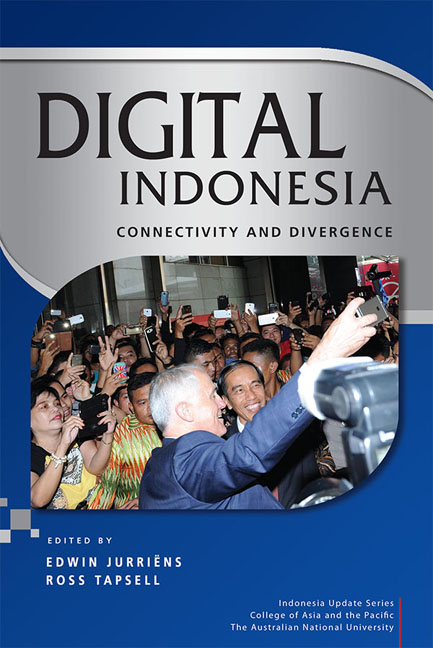Book contents
- Frontmatter
- Contents
- Tables
- Figures
- Contributors
- Acknowledgments
- Glossary
- Map of Indonesia
- 1 Challenges and opportunities of the digital ‘revolution’ in Indonesia
- PART 1 CONNECTIVITY
- PART 2 DIVERGENCE
- 5 Narrowing the digital divide
- 6 Laws, crackdowns and control mechanisms: digital platforms and the state
- 7 The state of cybersecurity in Indonesia
- PART 3 IDENTITY
- PART 4 KNOWLEDGE
- PART 5 COMMERCE
- Index
- Indonesia Update Series
7 - The state of cybersecurity in Indonesia
from PART 2 - DIVERGENCE
Published online by Cambridge University Press: 12 January 2018
- Frontmatter
- Contents
- Tables
- Figures
- Contributors
- Acknowledgments
- Glossary
- Map of Indonesia
- 1 Challenges and opportunities of the digital ‘revolution’ in Indonesia
- PART 1 CONNECTIVITY
- PART 2 DIVERGENCE
- 5 Narrowing the digital divide
- 6 Laws, crackdowns and control mechanisms: digital platforms and the state
- 7 The state of cybersecurity in Indonesia
- PART 3 IDENTITY
- PART 4 KNOWLEDGE
- PART 5 COMMERCE
- Index
- Indonesia Update Series
Summary
Indonesia has one of the largest populations of internet users in the world: 50 million in 2015 according to the Indonesian Internet Service Providers Association (Asosiasi Penyelenggara Jasa Internet Indonesia, or APJII). The number is continuing to grow because most Indonesians are not yet on the internet. Indonesia also has one of the world's largest internet exchanges, OpenIXP. An internet exchange is the physical meeting point ‘at which the networks of Internet Service Providers (ISPs), telecommunications carriers, content providers, webhosters and the like, meet to exchange IP traffic with one another’; the purpose of an internet exchange is ‘to decrease network costs, to improve network performance and to make [networks] more redundant’ (https://ams-ix.net/about/about-ams-ix). Indonesia's exchange connects more than 700 ISPs, content delivery networks (CDNs), government agencies and other service providers and has a peak throughput of 277 gigabits per second.
Indonesians are very active mobile phone users. The country has more mobile phones (270 million) than it has people (250 million) because some Indonesians own more than one mobile phone. Indonesians choose their providers on the basis of coverage, or to take advantage of the promotions that are available from time to time. The large number of mobile phone users in Indonesia makes security problems inevitable.
Even before the country had developed a high degree of IT expertise, Indonesians were enthusiastically embracing information technology to solve national problems. To create more transparency around elections, for example, the government began to use the internet to relay real-time vote tallies during the presidential elections of 1999. Then, in the 2014 election, a group calling itself Kawal Pemilu (Election Guardians) mobilised large numbers of young, IT-savvy Indonesians to electronically count the results from every polling station in the country, making it more difficult to (for want of a better word) ‘hack’ the election results. The electoral system still relies on paper-based voting, but a bill to allow electronic voting is being considered by parliament.
- Type
- Chapter
- Information
- Digital IndonesiaConnectivity and Divergence, pp. 110 - 124Publisher: ISEAS–Yusof Ishak InstitutePrint publication year: 2017

